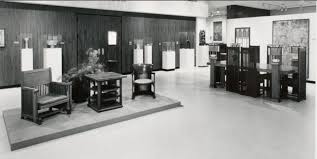OUTSTANDING RESEARCH SCIENTIST IS EARLY GREENE & GREENE CLIENT
by Ann Scheid
When Edith Claypole (1870-1915) received her M.D. degree from the Medical College of the University of Southern California in June 1904, she was living in her Greene and Greene bungalow at 50 South Grand Avenue in Pasadena. Already a noted research scientist when she commissioned the Greenes to design her house in 1903, Claypole requested that the architects include a laboratory room at the rear where she could carry out her research on infectious diseases.
Claypole had come to California in 1901, when she had to leave her studies at Cornell University Medical School to care for her invalid stepmother, a recent widow, in Pasadena. Her father, Edward Waller Claypole, a geology professor at Throop Polytechnic Institute (now Caltech), had died suddenly, and Edith and her twin sister Agnes, who was teaching zoology at Cornell, moved to Pasadena. They were both appointed to the faculty at Throop in 1901 to replace their father, Agnes in zoology and Edith in biology and bacteriology.
The twins were born in 1870 in Bristol, England. Their mother died shortly after their birth, and their father, forced to resign from his teaching position in Bristol because he refused to declare that Darwin’s theory of evolution was heresy, left the children in the care of relatives for a year until he had established himself in a teaching position at Antioch College in Ohio. There the twins were home-schooled under the guidance of their stepmother, a Canadian and their mother’s cousin, who herself was a scholar of literature and history. Brought up in an atmosphere of scientific inquiry and the equality of the sexes, the sisters led a discussion at Pasadena’s exclusive, male-only Twilight Club on “ladies’ night” in May 1902, titled “The Debt We Owe to Science,” an evening that the Greene brothers, who were members, might well have attended. We can speculate that this encounter may have led Edith to hire the Greenes to design her house in the following year.

Both Agnes and Edith excelled academically, graduating from Buchtel College in Akron, Ohio, where their father had been appointed professor, and earning Master’s degrees from Cornell in 1893, where Edith earned highest honors for her thesis on white blood cells. Both sisters later taught at Wellesley College, Edith teaching physiology and histology for 5 years, and serving as interim director of the zoology department. Agnes left Wellesley to study at the University of Chicago, where she earned her doctorate in zoology in 1896. Edith returned to Cornell to study medicine in 1899, where Agnes had begun teaching zoology, the first woman allowed to instruct laboratory classes that were mandatory for all students.
While living in Pasadena, Edith continued her medical studies at USC, working in the laboratory of Dr. Norman Bridge as a pathologist, where she made cultures and vaccines and contributed to diagnoses. Bridge, who had detected the tubercular bacillus while examining his own sputum through the microscope in his Chicago laboratory, had moved from Chicago to Sierra Madre in the 1890s, one of the many “health-seekers” in quest of a cure in the Southern California climate. Miraculously, his health improved, and he led an active life into his 80s.
Bridge became Edith’s mentor, supporting her research and playing a significant role in defending her against the California State Board of Medical Examiners, which refused on a technicality to give her a license to practice medicine, despite her M.D. degree. Dr. Bridge and the California Medical Association protested, threatening legal action, which caused the Board to back down, finally awarding her a license in October 1905.
In Bridge’s laboratory, Dr. Claypole began her path-breaking fundamental research on infectious diseases. Her interest in expanding the use of the modern microscope had come from her father, who used it to study animal fossils, leading to a better understanding of prehistoric creatures and ultimately, evolution. Her early research into the structure of blood cells as well as the interest in tuberculosis, which was claiming many victims at the time, led her to work on differentiating streptotricosis from tuberculosis, diseases that were often confused at the time. She developed a specific skin test that ruled out tuberculosis, facilitating later research into treatments for TB.

Agnes Claypole’s marriage to Dr. Robert O. Moody in 1903 and the sale of the Claypole family home on South Marengo Avenue gave Edith the funds and the freedom to commission her own house by Greene & Greene. The Moody’s moved to Berkeley shortly afterward, where Robert Moody took up appointment as a lecturer in anatomy at UC Berkeley. Edith followed in 1912, starting as a volunteer in Pathology at Berkeley, where she was soon hired as a Research Associate.
There she had access to more advanced microscopes, enabling her to make greater progress. She began work on a vaccine, but the onset of World War I led her to change course. She began research into developing an immunization for typhoid fever, which was ravaging armies. While she took all necessary precautions and initially displayed no symptoms, she eventually succumbed to the disease that she was attempting to cure. The university, her students and friends from Wellesley, as well as Dr. Bridge, published a memorial booklet in her memory, and the university established The Edith J. Claypole Memorial Research Fund in Pathology.
The Claypole bungalow at 50 South Grand in Pasadena had been sold in 1912 to Dr. Arthur T. Snell, a dentist practicing in Los Angeles. The newspaper described the property as “highly improved with shrubbery, rose bushes and other things that add to the attractiveness of the house and grounds. The bungalow was designed by Greene & Greene and is artistic in every way.”
The author thanks Megs Meriwether, John Ripley and Ted Bosley for contributions to this article.


Leave a Reply